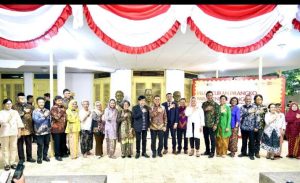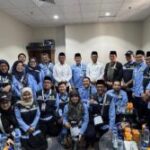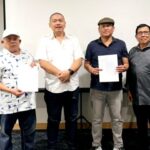Jakarta – Culture Minister Fadli Zon officially launched the National Founders Stamps on August 12, 2025, coinciding with the 123rd anniversary of Bung Hatta’s birth at the Proclamation Manuscript Museum in Jakarta.
Not only commemorating the 80th anniversary of Indonesia’s independence, this exhibition highlights the National Founders Stamp Series as a tribute to the figures who proclaimed independence, drafted the nation’s constitution, and guided Indonesia’s journey toward sovereignty.
The stamp launch reflects the Ministry of Culture’s commitment to preserving historical narratives as part of the nation’s collective memory. Stamps also serve as material culture, reinforcing national identity amid globalization.
In the presence of 17 family representatives of national founders—members of the Investigating Committee for Preparatory Work for Independence (BPUPKI) and the Preparatory Committee for Indonesian Independence (PPKI)—the minister emphasized their pivotal role in the nation’s struggle.
„Over 80 years of challenges, we have navigated our national journey remarkably. This would not have been possible without the contributions of our heroes, national founders, and independence proclaimers,“ he said.
The minister also noted that stamps serve as diplomatic bridges connecting nations. Beyond postal items, they archive historical events and act as tools for developmental communication.
„May this event remind us that we owe our presence here to the efforts, struggles, and sacrifices of our past leaders,“ he added.
Meanwhile, the Director-General of Cultural and Traditional Preservation, Restu Gunawan, stated that the National Founders Stamps aim to educate younger generations.
„This initiative promotes awareness of the national figures‘ roles, especially among Indonesian youth and the international community,“ he explained.
Restu added, „Learning history through stamps is an excellent approach,“ concluding his remarks.
The exhibition also honored Bung Hatta’s birthday. „Today marks Bung Hatta’s 123rd birth anniversary—August 12, 1902,“ the minister noted, offering prayers for the late leader.
As a tribute to Bung Hatta’s contributions, a ceremonial tumpeng (rice cone) cutting was held, followed by the signing of the stamp covers.
Minister Fadli Zon led the tumpeng ceremony, joined by Deputy Minister Giring Ganesha Djurmaryo, the Director-General of Cultural Preservation, and Bung Hatta’s family representatives, Meutia Hatta and Gemala Hatta.
The official stamp launch was marked by a hammer strike on the stamp plaque by Minister Fadli Zon, accompanied by Deputy Minister Giring Ganesha Djumaryo.
Attendees included the Inspector General of the Ministry, Fryda Lucyana; Director-General Restu Gunawan; Head of Domestic Policy Strategy Yusharto; Social Empowerment Director-General Mira Riyati Kurniasih; PT Pos Indonesia Commissioner Muhammad Budi Djatmiko; and national founders‘ family representatives.
The exhibition featured 80 stamps—79 honoring BPUPKI and PPKI figures instrumental in Indonesia’s independence and one depicting the PPKI meeting hall (Road van Indie) on Pejambon 2 Street, Jakarta.
Produced in 500 sets, the stamps include a booklet detailing the 79 figures.
Also present were Deputy Territorial Assistant to the TNI Commander Brig. Gen. Bambang Hadi Suseno; Jakarta Provincial Education Bureau Head Fajar Eko Satriyo; National Police PR Division Head Brig. Gen. Tjahyono Saputro; History and Museums Director Agus Mulyana; and Traditional Beliefs Director Sjamsul Hadi.
Other attendees included the Head of Cultural Preservation Region V, Agus Widiatmoko; PT Pos Indonesia executives; Indonesian Philatelic Association members; related ministry representatives; and artists.
Proclamation Manuscript Museum
The Proclamation Manuscript Museum is a cultural institution dedicated to preserving and showcasing historical manuscripts related to significant national proclamations, often highlighting pivotal moments in a country’s history. It may feature original documents, drafts, or artifacts tied to declarations of independence, constitutional reforms, or other landmark announcements. The museum serves as an educational resource, offering insights into the political and social contexts of these transformative events. (Note: If referring to a specific museum, such as one in Indonesia or Ireland, additional historical details could be included.)
National Founders Stamps
The **National Founders Stamps** are a series of commemorative postage stamps honoring the key figures who played pivotal roles in the founding or development of a nation. These stamps often feature historical leaders, revolutionaries, or cultural icons, serving as both a tribute and a means of promoting national heritage. Their issuance typically aligns with significant anniversaries or events, blending philately with historical remembrance. (Example: The U.S. „Founding Fathers“ stamps or similar series in other countries.)
Investigating Committee for Preparatory Work for Independence (BPUPKI)
The Investigating Committee for Preparatory Work for Independence (BPUPKI) was a Japanese-established organization formed in March 1945 to prepare for Indonesia’s independence. It played a crucial role in drafting the foundational principles of the future Indonesian state, including the Pancasila ideology. The committee’s work laid the groundwork for Indonesia’s proclamation of independence on August 17, 1945.
Preparatory Committee for Indonesian Independence (PPKI)
The Preparatory Committee for Indonesian Independence (PPKI) was a body established on August 7, 1945, by the Japanese occupation authorities to finalize preparations for Indonesia’s independence. After Japan’s surrender in World War II, the PPKI, led by Sukarno and Hatta, proclaimed Indonesia’s independence on August 17, 1945, and later helped draft the country’s first constitution. The committee played a crucial role in the early formation of the Indonesian government and its foundational policies.
Road van Indie
„Road van Indie“ (Road to the Indies) refers to historic trade routes connecting Europe to Asia, particularly the Dutch East Indies (modern-day Indonesia), during the colonial era. Established by Dutch traders in the 16th-17th centuries, these maritime routes were vital for the spice trade and colonial expansion. The term symbolizes the economic and cultural exchanges, as well as the colonial exploitation, that shaped global history.
Pejambon 2 Street
Pejambon 2 Street is a notable location in Central Jakarta, Indonesia, historically linked to the Dutch colonial era. The area is known for its proximity to significant government buildings and cultural landmarks, such as the Pancasila Building (formerly the Volksraad or colonial parliament). Today, it reflects a blend of colonial heritage and modern urban development.
Bung Hatta
Bung Hatta refers to the legacy of Mohammad Hatta, Indonesia’s first vice president and a key figure in the country’s independence movement. The term is often associated with landmarks or institutions named in his honor, such as the Bung Hatta Grand Mosque in Bukittinggi, his birthplace, or the Bung Hatta University in Padang. These sites celebrate his contributions to Indonesia’s struggle for freedom and his role as a founding father alongside Sukarno.
PT Pos Indonesia
PT Pos Indonesia is the national postal service of Indonesia, established in 1746 during the Dutch colonial era as *Posterij* and later renamed after independence. It provides mail, logistics, and financial services across the archipelago, playing a key role in connecting the country’s diverse regions. Today, it has expanded into digital services while preserving its historic post offices, some of which date back to the colonial period.






